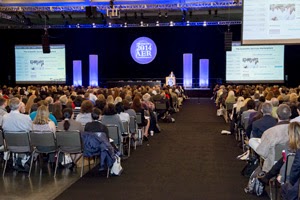by Dr. Toby Schonfeld, Human Subjects Research Review Official, Environmental Protection Agency
Dr. Toby Schonfeld, Human Subjects Research Review Official at the Environmental Protection Agency (EPA), recently shared her experience at PRIM&R’s 2014 Advancing Ethical Research Conference on the EPA’s official science blog, “It All Starts with Science.” We are pleased to share her thoughts and observations with our community, and thank Dr. Schonfeld and the EPA for allowing us to do so.
You know that great feeling you get when you gather with friends or family members that you
haven’t seen in a while? I’m talking about that “I’m part of something special” feeling, where you barely even have to finish a sentence before others are agreeing with you, or exclaiming “Me too!” or just seem to really understand your perspective. In short, these people “get” you.
That’s the feeling I get when I attend the annual meeting of Public Responsibility in Medicine and Research (PRIM&R), as my EPA colleague Dan Nelson and I did in early December. PRIM&R is a place where people who care deeply about human subject research protections gather to share best practices and to learn from experts in ethics and compliance about contemporary strategies for human subject protections. Officially, the organization provides “professionals responsible for ensuring research protections, and those involved in the design and implementation of research protocols, with education, practical tools, and cutting-edge strategies” (PRIM&R website accessed December 23, 2014: http://www.primr.org/about/).
This year’s Advancing Ethical Research conference was no exception. More than 2,700 professionals traveled to Baltimore to participate in 130-plus break-out sessions and several special events throughout the three-day meeting.
The keynote speakers were particularly engaging this year. John Wilbanks, the Chief Commons Officer at Sage Bionetworks, discussed innovative processes for informed consent in the mobile era. The Director of the National Institutes of Allergy and Infectious Diseases, Anthony Fauci, drew a vivid picture of the history of clinical trials in HIV/AIDS over the past three decades, and included important comparisons between this history and current research involving ebola. Finally, Susan Lederer from the University of Wisconsin-Madison gave insights into the life of Henry Beecher, well known as the “whistle-blower” of unethical research in the 1960s.
Attending meetings like PRIM&R enhances our work at the Agency in a number of ways. Since EPA is one of the 16 agencies that has signed onto the Department of Health and Human Services’ regulation to protect human subjects (known as the Common Rule), we share a “parent” regulation with many other research partners. Interacting with others who apply the regulation to a variety of kinds of research enables us to learn from them how they approach issues and share with them our approaches.
As part of the sharing process, Dan and I held a “meet the EPA” session, where staff from Institutional Review Boards across the country learned about EPA’s specific research protections. Now, they will understand our particular context when research proposals supported by EPA’s Science to Achieve Results (STAR) grant program come across their desks. Dan and I also participated in several other sessions as presenters, which enabled us to share our expertise with the rest of the human research protections community.
Through these and similar mechanisms, the Agency supports and advances important science while also ensuring that those of us who review projects for regulatory compliance are part of a community of practice that also cares deeply about the protection of the volunteers who so generously agree to be human subjects to further research. For Dan and me, they are all kind of like family.
About the Author: Dr. Toby Schonfeld is EPA’s Human Subjects Research Review Official and the Director of the Agency’s Program in Human Research Ethics and Oversight.
Editor’s Note: The opinions expressed here are those of the author. They do not reflect EPA or PRIM&R policy, endorsement, or action.


No comments! Be the first commenter?